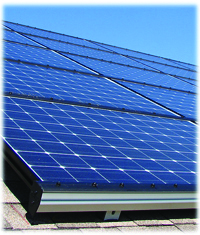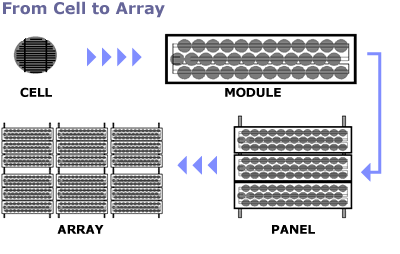Solar Electric Photovoltaic Modules
  Photovoltaic (PV) Power Photovoltaic (PV) Power
PV is emerging as a major power resource, steadily becoming more affordable and proving to be more reliable than utilities. Photovoltaic power promises a brighter, cleaner future for our children.
Using the technology we have today we could equal the entire electric production of the United States with photovoltaic power plants using only about 12,000 square miles.
In 1839, Edmund Becquerel discovered the process of using sunlight to produce an electric current in a solid material, but it wasn't until a century later that scientists eventually learned that the photovoltaic effect caused certain materials to convert light energy into electrical energy.
The photovoltaic effect is the basic principal process by which a PV cell converts sunlight into electricity. When light shines on a PV cell, it may be reflected, absorbed, or pass right through. The absorbed light generates electricity.
In the early 1950s, photovoltaic (PV) cells were developed as a spin-off of transistor technology. Very thin layers of pure silicon are impregnated with tiny amounts of other elements. When exposed to sunlight, small amounts of electricity are produced. Originally this technology was a costly source of power for satellites but it has steadily come down in price making it affordable to power homes and businesses.

| Cells |
|
Semiconductor device that converts sunlight into direct current (DC) electricity |
| Modules |
|
PV modules consist of PV cell circuits sealed in an environmentally protective laminate and are the fundamental building block of PV systems |
| Panels |
|
PV panels include one or more PV modules assembled as a pre-wired, field-installable unit |
| Array |
|
A PV array is the complete power-generating unit, consisting of any number of PV modules and panels
|
 |
Photovoltaic Cell |
A single PV cell is a thin semiconductor wafer made of two layers generally made of highly purified silicon (PV cells can be made of many different semiconductors but crystalline silicon is the most widely used). The layers have been doped with boron on one side and phosphorous on the other side, producing surplus of electrons on one side and a deficit of electrons on the other side.
When the wafer is bombarded by sunlight, photons in the sunlight knock off some of excess electrons, this makes a voltage difference between the two sides as the excess electrons try to move to the deficit side. In silicon this voltage is .5 volt
Metallic contacts are made to both sides of the semiconductor. With an external circuit attached to the contacts, the electrons can get back to where they came from and a current flows through the circuit. This PV cell has no storage capacity, it simply acts as an electron pump.
The amount of current is determined by the number of electrons that the solar photons knock off. Bigger cells, more efficient cells, or cells exposed to more intense sunlight will deliver more electrons.
 |
Photovoltaic Modules |
A PV module consists of many PV cells wired in parallel to increase current and in series to produce a higher voltage. 36 cell modules are the industry standard for large power production.
The module is encapsulated with tempered glass (or some other transparent material) on the front surface, and with a protective and waterproof material on the back surface. The edges are sealed for weatherproofing, and there is often an aluminum frame holding everything together in a mountable unit. In the back of the module there is a
junction box, or wire leads, providing electrical connections.
There are currently four commercial production technologies for PV Modules:
Single Crystalline
This is the oldest and more expensive production technique, but it's also the most efficient sunlight conversion technology available. Module efficiency averages about 10% to 12%*
Polycrystalline or Multicrystalline
This has a slightly lower conversion efficiency compared to single crystalline but manufacturing costs are also lower. Module efficiency averages about 10% to 11%*
String Ribbon
This is a refinement of polycrystalline production, there is less work in production so costs are even lower. Module efficiency averages 7% to 8%*
Amorphous or Thin Film
Silicon material is vaporized and deposited on glass or stainless steel. The cost is lower than any other method. Module efficiency averages 5% to 7%*
*Check with manufacturer for module's accurate conversion efficiency.
 |
Photovoltaic Panels |
PV panels include one or more PV modules assembled as a pre-wired, field-installable unit. The modular design of PV panels allows systems to grow as needs change. Modules of different manufacture can be intermixed without any problem, as long as all the modules have rated voltage output within 1.0 volt difference.
 |
Photovoltaic Array |
A PV Array consists of a number of individual PV modules or panels that have been wired together in a series and/or parallel to deliver the voltage and amperage a particular system requires. An array can be as small as a single pair of modules, or large enough to cover acres.
12 volt module is the industry standard for battery charging. Systems processing up to about 2000 watt-hours should be fine at 12 volts. Systems processing 2000 - 7000 watt-hours will function better at 24 volt. Systems running more than 7000 watt-hours should probably be running at 48 volts.
Follow the link below to see samples of complete photovoltaic-based electrical systems: Configured Solar Electric Systems
 |
Photovoltaic Module Performance |
The performance of PV modules and arrays are generally rated according to their maximum DC power output (watts) under Standard Test Conditions (STC). Standard Test Conditions are defined by a module (cell) operating temperature of 25o C (77 F), and incident solar irradiant level of 1000 W/m2 and under Air Mass 1.5 spectral distribution. Since these conditions are not always typical of how PV modules and arrays operate in the field, actual performance is usually 85 to 90 percent of the STC rating.
Today’s photovoltaic modules are extremely safe and reliable products, with minimal failure rates and projected service lifetimes of 20 to 30 years. Most major manufacturers offer warranties of twenty or more years for maintaining a high percentage of initial rated power output. When selecting PV modules, look for the product listing (UL), qualification testing and warranty information in the module manufacturer’s specifications.
 |
Photovoltaic Applications |
PV has been routinely used for roadside emergency phones and many temporary construction signs, where the cost and trouble of bringing in utility power outweighs the higher initial expense of PV, and where mobile generator sets present more fueling and maintenance trouble.
More than 100,000 homes in the United States, largely in rural sites, now depend on PVs as a primary power source, and this figure is growing rapidly as people begin to understand how clean and reliable this power source is, and how deeply our current energy practices are borrowing from our children.
PV costs are now down to a level that makes them the clear choice not just for remote applications, but for those seeking environmentally safer solutions and independence from the ever-increasing utility power costs.
 |
Photovoltaic Benefits |
- Solar power provided by photovoltaic systems lower your utility bills and insulate you from utility rate hikes and price volatility due to fluctuating energy prices
- Installing a solar system increases property value and home resale opportunities
- Purchase of a solar power system allows you to take advantage of available tax and financial incentives
- Because they don't rely on miles of exposed wires, residential PV systems are more reliable than utilities, particularly when the weather gets nasty.
- PV modules have no moving parts, degrade very, very slowly, and boast a life span that isn't fully known yet, but will be measured in decades.
- Solar electric systems are quiet, reliable, fossil-fuel free
- Unlike mobile power generators, avoids greenhouse gas emissions
View all PV solar panels available on our shopping cart
Other Products:
PV Inverters
PV Controllers
PV Batteries
Complete PV Systems
View All PV Products
Additional information:
30% Rebate
PV Basics
FAQ
|